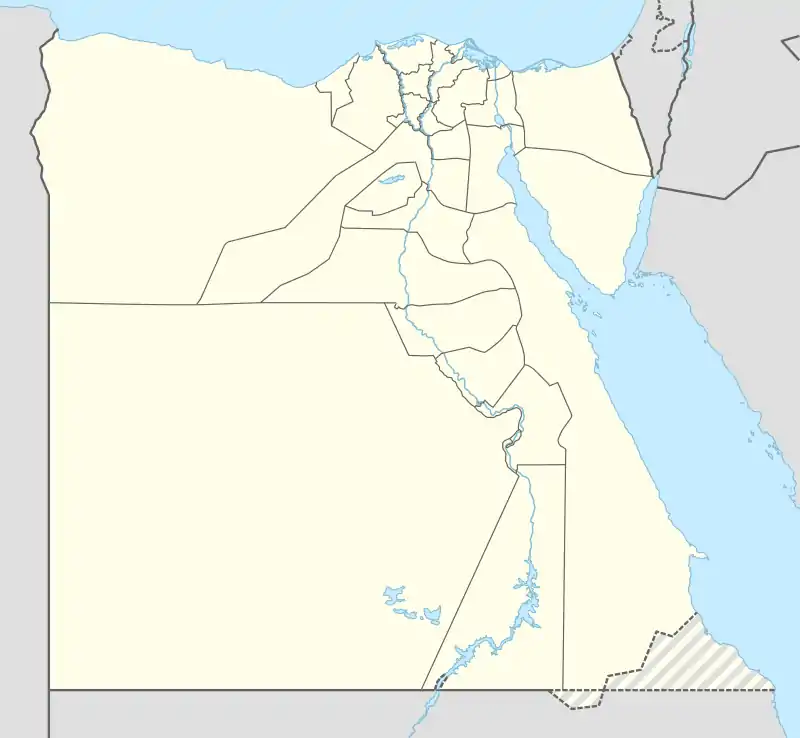Tahta
Tahta (Arabic: طهطا / IPA: [ˈtˤɑhtˤɑ], ALA-LC: Ṭahṭā; Greek: Τοετω;[4] Coptic: ⲧϩⲟⲧⲏ, Coptic pronunciation: [dəˈhodæ]) is a city in the Sohag Governorate of Upper Egypt. It is located on the west bank of the Nile in an area known for its agricultural richness. Tahta had a population of 85,528 in the 2017 census.[5] Egyptologists believe that the modern name may derive from the word Ta-ho-ty (Ancient Egyptian: Tȝ-ḥw.t-Ty).[2][3] Two famous monasteries are located near Tahta, the White Monastery and the Red Monastery. The town has a small but significant Coptic Catholic community.[6] Its most famous resident was the reformist intellectual Rifa'a al-Tahtawi, who was born in Tahta in 1801, and who wrote and translated many books following his trip to Paris in 1826 as the imam and chaplain for the first group of Egyptians whom Mehmet Ali Pasha (Muhammad Ali Pasha) sent to study in western Europe.
Tahta
ⲧϩⲟⲧⲏ طهطا | |
|---|---|
 Tahta Location in Egypt | |
| Coordinates: 26°46′06″N 31°30′02″E | |
| Country | Egypt |
| Governorate | Sohag |
| Area | |
| • Total | 3.728 sq mi (9.656 km2) |
| Elevation | 217 ft (66 m) |
| Population (2021)[1] | |
| • Total | 182,052 |
| • Density | 49,000/sq mi (19,000/km2) |
| Time zone | UTC+2 (EST) |
| ḥt tj(t)[2] in hieroglyphs | ||||||
|---|---|---|---|---|---|---|
| ḥt tj(t)[3] in hieroglyphs | |||||
|---|---|---|---|---|---|
| Era: 3rd Intermediate Period (1069–664 BC) | |||||
Villages
Villages within the jurisdiction of Tahta include:
- Bani Harb (Egyptian Arabic: بنى حرب)
- Nazlit El Qady (Egyptian Arabic: نزلة القاضى)
- Banga (Egyptian Arabic: بنجا)
- El Sawalim (Egyptian Arabic: السوالم)
- Shattoura (Egyptian Arabic: شطوره)
- El Soffeha (Egyptian Arabic: الصفيحه)
- El Kom El Asfar (Egyptian Arabic: الكوم الأصفر)
- Zein Eld Din (Egyptian Arabic: زين الدين)
- Nazlit Ali (Egyptian Arabic: نزلة على)
- Elsawamaa Gharb (Egyptian Arabic: الصوامعه غرب)
- Banhao (Egyptian Arabic: بنهو)
- Bani Ammar (Egyptian Arabic: بنى عمار)
- Enibis (Egyptian Arabic: عنيبس)
Notable residents
See also
References
- "Ṭahṭā (Kism (urban and rural parts), Egypt) - Population Statistics, Charts, Map and Location". www.citypopulation.de. Retrieved 17 June 2023.
- Wallis Budge, E. A. (1920). An Egyptian hieroglyphic dictionary: with an index of English words, king list and geological list with indexes, list of hieroglyphic characters, coptic and semitic alphabets, etc. Vol II. John Murray. p. 1019.
- Gauthier, Henri (1927). Dictionnaire des Noms Géographiques Contenus dans les Textes Hiéroglyphiques Vol .4. p. 141. Gauthier refers to Daressy's identification.
- Paprocki, Maciej (2019). Roads in the Deserts of Roman Egypt: Analysis, Atlas, Commentary. Oxbow Books. p. 22. ISBN 9781789251593. Retrieved 14 March 2020.
- "The population of the governorates of Egypt according to census results". City Population.
- Mayeur-Jaouen, Catherine (2019). Voyage en Haute-Égypte : prêtres, coptes et catholiques. Paris: CNRS Éditionas. ISBN 978-2-271-11614-7. OCLC 1081303684.